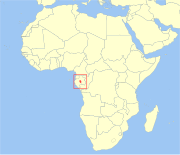Allochrocebus
| Allochrocebus | |
|---|---|

| |
| L'Hoest's monkey | |
| Scientific classification | |
| Domain: | Eukaryota |
| Kingdom: | Animalia |
| Phylum: | Chordata |
| Class: | Mammalia |
| Order: | Primates |
| Suborder: | Haplorhini |
| Infraorder: | Simiiformes |
| Family: | Cercopithecidae |
| Tribe: | Cercopithecini |
| Genus: | Allochrocebus Elliot, 1913 |
| Species and subspecies[1] | |
| |
Allochrocebus is a primate genus including the terrestrial guenons:[1] the L'Hoest's monkey,[2] the Preuss's monkey,[3] and the sun-tailed monkey.[4]
Taxonomy & systematics[edit]
Formerly included in genus Cercopithecus, the three species of terrestrial guenons are now included in genus Allochrocebus.[5][6]
| Common name | Scientific name and subspecies | Range | Size and ecology | IUCN status and estimated population |
|---|---|---|---|---|
| L'Hoest's monkey | A. lhoesti (P. L. Sclater, 1899) |
Central Africa
|
Size: 31–69 cm (12–27 in) long, plus 48–10 cm (19–4 in) tail[7] Habitat: Forest[8] Diet: Fruit, leaves, mushrooms, and invertebrates[7] |
VU
|
| Preuss's monkey | A. preussi (Matschie, 1898) Two subspecies
|
West-central Africa
|
Size: 45–61 cm (18–24 in) long, plus 49–69 cm (19–27 in) tail[9] Habitat: Forest and grassland[10] Diet: Fruit, seeds, shoots, leaves, buds, flowers, and mushrooms[9] |
EN
|
| Sun-tailed monkey | A. solatus (M. J. S. Harrison, 1988) |
West-central Africa
|
Size: 45–58 cm (18–23 in) long, plus 56–76 cm (22–30 in) tail[11] Habitat: Forest[12] Diet: Fruit, seeds, and invertebrates[11] |
NT
|
References[edit]
- ^ a b "Allochrocebus Elliot, 1913". ITIS. doi:10.5066/F7KH0KBK. Retrieved 19 February 2019.
- ^ Ukizintambara, T.; Olupot, W.; Hart, J. (2019). "Allochrocebus lhoesti". IUCN Red List of Threatened Species. 2019: e.T4220A92345122. doi:10.2305/IUCN.UK.2019-3.RLTS.T4220A92345122.en. Retrieved 9 September 2022.
- ^ Cronin, D.T.; Maisels, F.; Ndeloh, D.; Gadsby, E. (2019) [errata version of 2019 assessment]. "Allochrocebus preussi". IUCN Red List of Threatened Species. 2019: e.T4227A161178708. doi:10.2305/IUCN.UK.2019-2.RLTS.T4227A161178708.en. Retrieved 9 September 2022.
- ^ Abernethy, K.; Maisels, F.; Coad, L. (2019) [errata version of 2019 assessment]. "Allochrocebus solatus". IUCN Red List of Threatened Species. 2019: e.T4230A154209091. doi:10.2305/IUCN.UK.2019-1.RLTS.T4230A154209091.en. Retrieved 9 September 2022.
- ^ Jonathan Kingdon, David Happold, Michael Hoffmann, Thomas Butynski, Meredith Happold und Jan Kalina (Hrsg.): Mammals of Africa, Volume II: Primates A&C Black, 2013. ISBN 978-1-4081-2257-0
- ^ Mittermeier, Russell A., Anthony B. Rylands & Don E. Wilson: Handbook of the Mammals of the World. Volume 3. Primates, Lynx Edicions, Barcelona, 2013 ISBN 978-84-96553-89-7
- ^ a b Ferguson, Bess (2011). "Cercopithecus lhoesti". Animal Diversity Web. University of Michigan. Archived from the original on July 24, 2023. Retrieved July 24, 2023.
- ^ a b Ukizintambara, T.; Olupot, W.; Hart, J. (2019). "Allochrocebus lhoesti". IUCN Red List of Threatened Species. 2019: e.T4220A92345122. doi:10.2305/IUCN.UK.2019-3.RLTS.T4220A92345122.en.
- ^ a b Kingdon 2015, p. 156
- ^ a b Cronin, D. T.; Maisels, F.; Ndeloh, D.; Gadsby, E. (2019) [errata version of 2019 assessment]. "Allochrocebus preussi". IUCN Red List of Threatened Species. 2019: e.T4227A161178708. doi:10.2305/IUCN.UK.2019-2.RLTS.T4227A161178708.en.
- ^ a b Kingdon 2015, p. 157
- ^ a b Abernethy, K.; Maisels, F.; Coad, L. (2019) [errata version of 2019 assessment]. "Allochrocebus solatus". IUCN Red List of Threatened Species. 2019: e.T4230A154209091. doi:10.2305/IUCN.UK.2019-1.RLTS.T4230A154209091.en.
Sources[edit]
- Kingdon, Jonathan (2015). The Kingdon Field Guide to African Mammals (Second ed.). Bloomsbury Publishing. ISBN 978-1-4729-2531-2.







